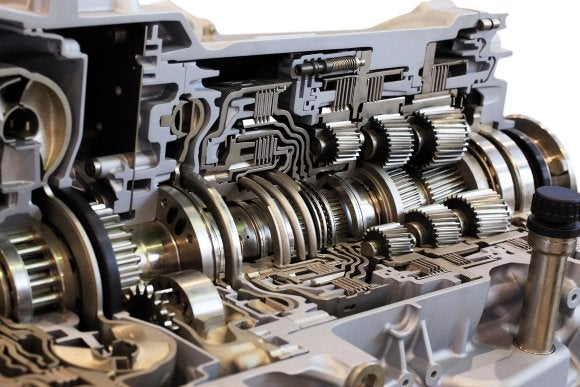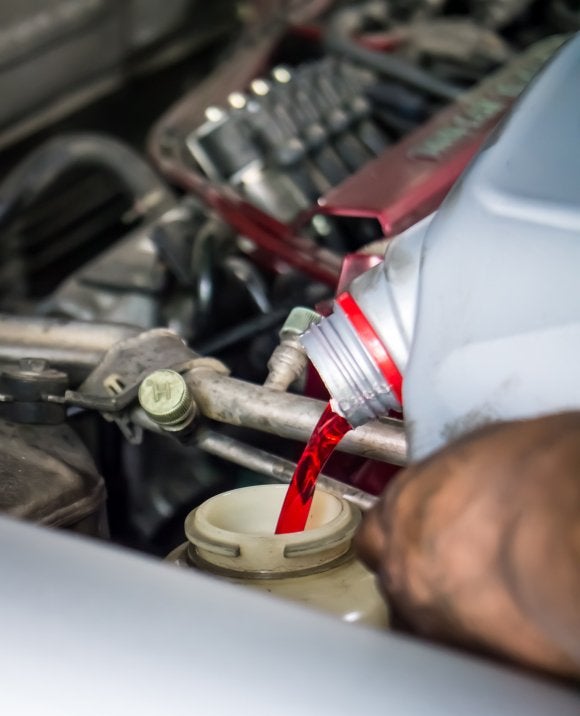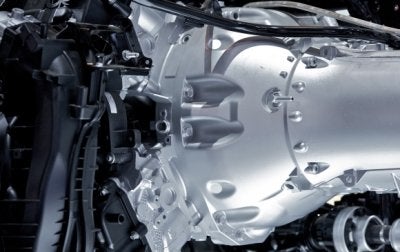-
Maintaining Your Honda’s Transmission
Do you have a 1998 Honda Accord? If so, this video will show you exactly where the transmission fluid dipstick is located and tell you how to add transmission fluid. If you drive a different year, make, or model, this video is still beneficial as it provides some general tips for checking and adding transmission fluid to your vehicle.
To keep your Honda in tip-top shape, visit a transmission repair shop in Silver Spring, MD that specializes in Honda transmission service . Trusting your vehicle with technicians who know the ins and outs of Honda transmission maintenance and repair will give you the peace of mind of knowing that your vehicle is in the best hands for the job. For transmission problems big and small, visit Superior Transmissions. Call (301) 960-2282 to learn more about the Honda transmission services offered by Superior Transmissions.
-
A Car Owner’s Guide to Selecting Automatic Transmission Fluid
If you take your car to a transmission service shop in Bethesda for routine maintenance, you can leave it up to the professionals to select the best fluid for your automatic transmission. However, if you’re the do-it-yourself type you will need to choose your own transmission fluid when changing out the old fluid. It’s recommended that you leave this maintenance service to the professionals, but if you insist on changing your own transmission fluid make sure you choose the right fluid to prevent damaging your car’s transmission. Here are some important things to know about selecting automatic transmission fluid for your vehicle.

When to Change Transmission Fluid
First and foremost, when talking about transmission fluid it’s important that you know when you need to change the fluid inside your transmission. Generally, transmission fluid should be changed every 24,000 to 36,000 miles, or approximately every two to three years. Refer to your car’s owner’s manual for more specific transmission fluid change interval information related to your make and model. You can also ask your transmission technician for a recommended fluid change interval based on the condition of your transmission.
Automatic Transmission Fluid Types
There are two main types of transmission fluid, Dextron and Mercon. Your owner’s manual will tell you which type of transmission fluid your vehicle uses. You will also need to decide between synthetic and conventional transmission fluid . Synthetic fluid is more expensive than conventional oil, but it performs better at higher temperatures and provides better overall protection. However, if you drive an older vehicle the transmission might not be designed with synthetic fluid in mind.
Transmission Fluid Brands
When it comes to brands, there’s little difference between the major transmission fluid brands. If you want a specific brand recommendation, check with a transmission repair shop in your area or ask for a recommendation at the auto parts store you frequent to purchase fluid.
-
Understanding a Delayed Engagement
Although transmission failure can sometimes occur suddenly and without warning, in most cases there are lots of subtle signs that precede the event. One such sign of impending transmission trouble is a delayed engagement, in which there is a delay between when you shift into drive or reverse and when the vehicle actually gets out of neutral and into gear. This often occurs when the internal seals on the clutches and bands wear down or become hard from infrequent fluid replacement. Although delayed engagement can be an inconvenience at first, ignoring the problem can result in bigger transmission issues later on.
If you’re experiencing any sort of transmission slippage or delayed gear engagement, visit a transmission repair shop serving Silver Spring, MD and the surrounding areas to have the problem diagnosed. There could be any number of problems causing delayed engagement or other drivability issues, so let a transmission repair specialist have a look so you can get back on the road without any drivability or performance issues.

-
Checking Your Manual Transmission Fluid
You don’t have to be a transmission repair expert to keep your transmission in great shape. Routinely checking the fluid, for example, can clue you in to potential problems with your transmission and help you avoid running on low fluid which can strain the transmission and shorten its life. But how exactly do you check the transmission fluid anyways? You can see how by watching this video from an ASE-certified master mechanic.
If you notice your transmission fluid is very dirty or smells burnt, visit a transmission repair shop in Montgomery County MD for a transmission flush service . This will completely flush out the dirty, slugged-up fluid so fresh transmission can be added to the system. Clean fluid is essential to transmission lubrication, and a well-lubricated transmission runs better and has a longer lifespan than transmissions that become worn down due to poor lubrication.
-
How to Tell When Your Car Needs a Transmission Flush
Generally speaking, it’s a good idea to get a transmission flush every 30,000 miles or every two years, whichever comes first. However, depending on the age and condition of your transmission and other factors such as how you drive and how well you maintain your transmission, there may be times when you need to get a transmission flush sooner. If you recognize any of these common signs, visit a transmission shop in Rockville, and Bethesda for a transmission flush service.

Problems Shifting Gears
Regardless of whether you drive an automatic or manual, problems shifting gears is an indication that the transmission fluid contains too much dirt or sludge which is causing a sluggish response in the gearbox. For automatic transmissions, you may notice that the vehicle changes gears faster or slower than normal. In manual transmission vehicles, you may it very difficult to change the gears at all. In either case, visit a transmission repair shop to find out if a flush is the answer to the problems you are experiencing.
Vehicle Surging
Another tell-tale sign of a transmission in need of a flush and fill is unexplainable surging of the vehicle. Transmission fluid that is very dirty or full of sludge does not allow for adequate flow through the transmission, which can cause the vehicle to surge forward for no good reason. This problem is usually most noticeable when the vehicle slows down and comes to a stop at a light or stop sign.
Dirty or Burnt-Smelling Transmission Fluid
As a part of maintaining your vehicle, get in the habit of inspecting the transmission fluid on a regular basis. If the fluid looks very dirty or smells burnt, visit a transmission repair shop in Silver Spring, MD for a flush service so you can have fresh fluid added for optimal performance, lubrication, and efficiency.
-
What Does the Transmission Do?
Drivers have lots of questions about transmissions, but perhaps the most important one to answer is about how transmissions work. Although you aren’t expected to know the name of every component that makes up the transmission (there are thousands) or the scientific principles that make transmission work, knowing the basics of what your transmission does and how it operates can help you identify when something is wrong and understand the importance of visiting an experienced transmission repair shop in Rockville and Bethesda for all your transmission service needs.

Tra nsmissio n Componen ts
The first step in learning about how transmissions work is to understand the main components inside your transmission. Learning about these components can also help when talking to your transmission repair mechanic about the problems you are experiencing or the services recommended for your transmission. The main components that make up an automatic transmission include:
- Planetary gear sets that provide the various forward and reverse gear ratios
- Hydraulic system which pumps fluid through the valve body to control clutches, bands, and planetary gear sets
- Torque converter which acts like a clutch to allow the vehicle to come to a full stop and stay in gear while the engine is running
- Governors, modulators, or throttle cables that monitor speed and throttle position in order to determine when to shift gears higher or lower
Torque Conversion
Without getting too much into the physics and scientific principles that underlie the workings inside a transmission, the main duty of an automotive transmission is to convert torque created by the engine into forward or reverse acceleration. Transmissions essentially connect the engine to the front or rear wheels so the vehicle will move, and then disconnects when the vehicle is stopped so the engine doesn’t stall. In manual transmissions, this is accomplished by pressing in the clutch.
-
Diagnosing Automatic Transmission Problems
When your car experiences transmission problems, it is important to make an appointment with a transmission specialist right away. While some transmission problems may be minor, other issues could indicate serious troubles in your transmission system. There are several common automatic transmission problems to be on the lookout for. One of the most common issues is a transmission that hesitates to engage when you shift from park to drive. Slow engagement could point to a dirty filter or contaminated transmission fluid. For help diagnosing and repairing your transmission problems, be sure to schedule an appointment with a transmission specialist near Silver Spring, MD. To take a closer look at some of the most common automatic transmission problems , watch this video.
-
Pay Attention to Potential Transmission Problems
Transmission problems can put a serious halt to your daily driving routine. In the event that you ignore your automatic transmission problems for too long, the longevity and driving ability of your vehicle could significantly suffer. In order to keep your car in peak driving shape, you should be sure to schedule auto transmission repair at the first sign of transmission problems. A transmission shop in Montgomery County, MD will be able to repair any transmission issue that is plaguing your vehicle. To help prevent serious driving problems in the future, here is a look at some potential transmission problems that you should pay attention to.

Slipping Transmission
A slipping transmission is among the most common transmission problems. When you drive your automatic transmission vehicle, your car should smoothly transition between gears. In the event that your transmission begins slipping, you may find that your car jerks, stalls, or makes unusual noises when you step on the gas pedal. Your transmission repair specialist will be able to diagnose the precise cause of your slipping transmission.
Delayed Engagement
Delayed engagement is another transmission problem that should be addressed by a repair specialist. When your car experiences delayed transmission engagement, you may find that your vehicle pauses or stalls when you shift between park and drive. You might also feel as though your gas pedal is more sluggish than unusual. Since your vehicle should be fully responsive to your driving cues, delayed engagement should be repaired right away.
Leaking Fluid
Finally, leaking fluid is another significant transmission problem that should be addressed by your mechanic right away. When your vehicle is leaking transmission fluid, the safety and performance of your entire drivetrain could become compromised. As you are checking for transmission fluid leaks, you should be on the lookout for a dark red or brownish liquid on the pavement beneath your vehicle. You may also smell a burning odor as you are driving.
-
What Causes Hard Shifting?
Hard shifting is among the most common transmission problems that are reported by car owners. When your vehicle has trouble shifting between gears, you should be sure to visit a transmission specialist in Bethesda, and Rockville to receive a diagnosis of your problem. Typically, there are a few common causes for hard shifting in vehicles. Oftentimes, hard shifting can occur when you fail to change transmission fluid at the recommended interval. In the event that your transmission fluid gets low or dirty, your vehicle’s ability to shift could become compromised. Along with low transmission fluid, hard shifting can also be caused by electronic sensor issues. The only way to troubleshoot an electronic sensor problem is to bring your vehicle to a transmission shop that is equipped with computerized diagnostic equipment. With the right diagnostic tools, your transmission specialist will be able to determine whether your car’s computer is sending the wrong codes to your transmission. With the help of your transmission shop, you can get to the bottom of your car’s hard shifting troubles.
-
The Purpose of Transmission Fluid
Routine maintenance is an essential part of car ownership. Along with scheduling regular oil changes, tire rotations, and other services, you should also be sure to check your transmission fluid levels often . Low transmission fluid is the cause of many problems. When you change your transmission fluid at regularly scheduled intervals, you can help prevent some of the most common transmission repair issues that could plague your vehicle. A transmission specialist near Silver Spring, MD will be able to help you determine when your transmission fluid is too low. Read on for an overview of the role that transmission fluid plays in your vehicle.

How Transmissi on Fluid Works
Transmission fluid is a vital part of both automatic and manual transmission systems. When your transmission is in operation, your transmission fluid is designed to lubricate and protect the many moving parts that are used for your transmission to operate. Automatic transmissions also rely on transmission fluid to deliver power from the engine to the components of the transmission. Without properly maintained transmission fluid, your transmission would cease to function.
The Importance of Transmission Fluid Changes
Transmission specialists typically recommend that you change your transmission fluid between every 30,000 and 60,000 miles. Transmission fluid changes are essential for preserving the performance, safety, and longevity of your car. When you change your transmission fluid, you will remove harmful contaminants that could cause damage to your system. In addition, since transmission fluid breaks down over time, you can help prevent your transmission from degrading.
Potential Transmission Fluid Problems
Failing to follow the transmission fluid changing schedule for your vehicle could lead to very serious mechanical problems. For example, if you neglect to change your transmission fluid, the many moving components of your transmission could become damaged by metal shavings and other contaminants. In addition, routine transmission fluid changes could also help you avoid the need for a transmission rebuild in the future.
